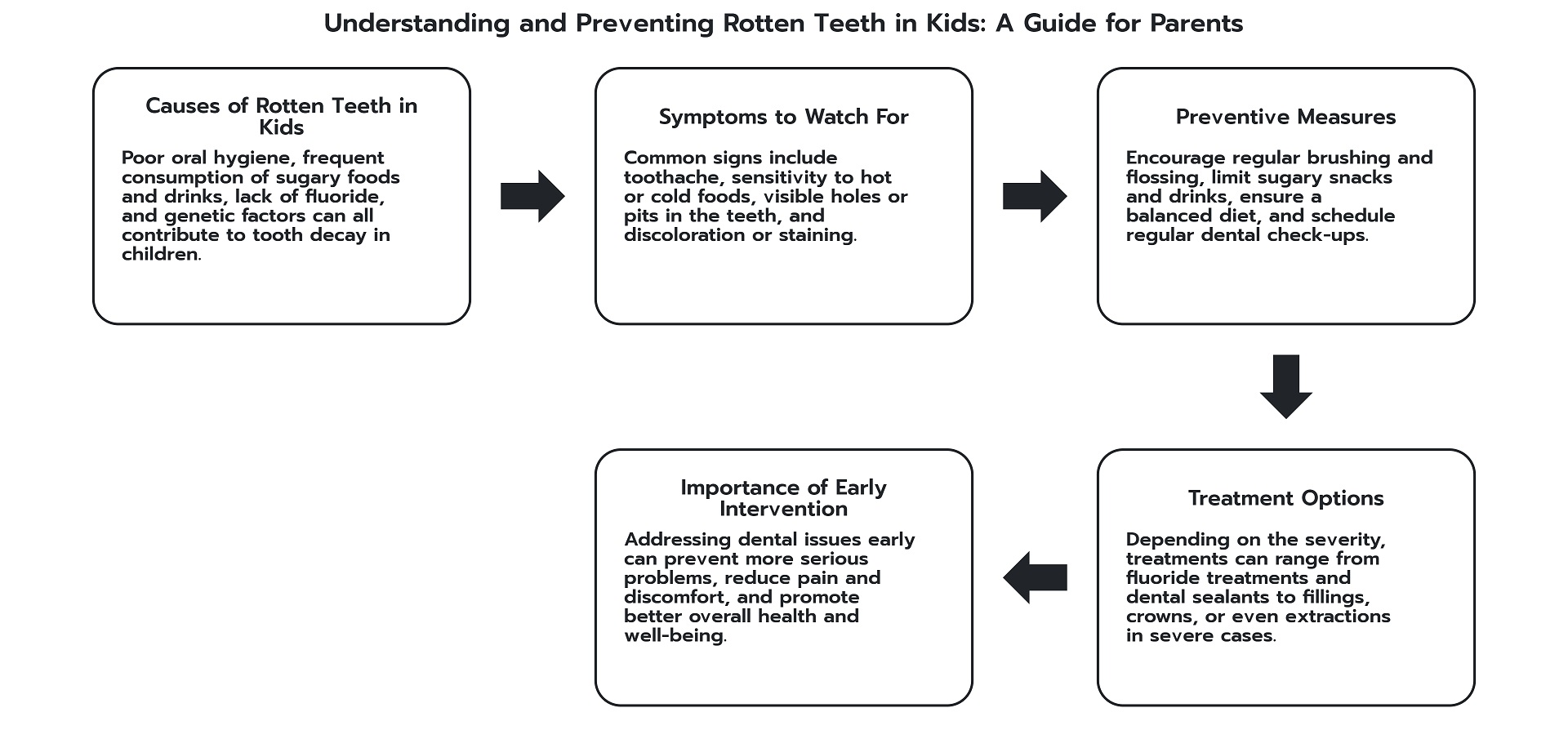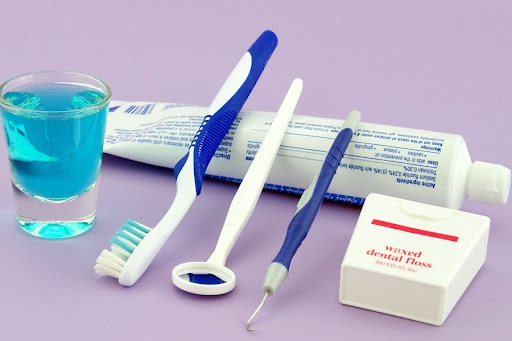Rotten Teeth in Children: Causes, Prevention, and Treatment

Tooth decay, or rotten teeth, is not just a concern for adults; it can also significantly affect children. Rotten teeth in children can lead to pain, discomfort, and long-term dental issues if not addressed promptly. Understanding the causes, prevention strategies, and treatment options for rotten teeth in children is crucial for ensuring their oral health and overall well-being. In this comprehensive guide, we will explore the key aspects of managing rotten teeth in children, helping parents make informed decisions about their children’s dental care.
1. Causes of Rotten Teeth in Children
Description:
Tooth decay in children can result from several factors, often related to oral hygiene, diet, and habits. Understanding these causes can help in effectively preventing and treating rotten teeth.
Key Points:
- Poor Oral Hygiene: Inadequate brushing and flossing can lead to plaque buildup, which contributes to tooth decay. Children may need guidance and supervision to establish a consistent oral care routine.
Effective Brushing and Flossing Techniques for Kids
- Dietary Habits: Frequent consumption of sugary snacks, sugary drinks, and carbohydrate-rich foods can increase the risk of tooth decay. Bacteria in the mouth feed on sugars, producing acids that erode tooth enamel.
The Role of Diet in Preventing Tooth Decay in Children
- Frequent Snacking: Snacking frequently without proper oral care can expose teeth to constant acid attacks, increasing the likelihood of decay.
- Lack of Fluoride: Fluoride helps strengthen tooth enamel and protect against decay. Inadequate fluoride exposure, whether from drinking water or dental products, can increase the risk of tooth decay.
- Dental Erosion: Acidic foods and beverages, such as citrus fruits and sodas, can contribute to enamel erosion and increase the risk of decay.
- Thumb Sucking and Prolonged Pacifier Use: These habits can affect the alignment of teeth and create spaces where plaque can accumulate, potentially leading to decay.
The Impact of Baby Bottle Tooth Decay: What Parents Need to Know
Common Causes of Tooth Decay in Children
Why It Matters:
Identifying the causes of rotten teeth in children helps in developing effective prevention strategies and ensuring timely treatment to avoid long-term dental issues.
How to Recognize Early Signs of Tooth Decay in Kids
2. Prevention Strategies for Rotten Teeth in Children
Description:
Preventing rotten teeth in children involves implementing good oral hygiene practices, making healthy dietary choices, and encouraging habits that promote dental health.
Key Points:
- Establish a Brushing Routine: Ensure that your child brushes their teeth twice daily with fluoride toothpaste. Supervise and assist them until they are able to brush effectively on their own, usually around age 7 or 8.
- Encourage Flossing: Introduce flossing as part of their daily routine once they have two teeth that touch. This helps remove plaque and food particles from between teeth.
- Limit Sugary Foods and Drinks: Reduce the intake of sugary snacks and beverages. Opt for healthier alternatives, such as fruits, vegetables, and water.
- Regular Dental Visits: Schedule regular dental check-ups every six months or as recommended by your dentist. Early visits help monitor your child’s dental health and catch potential issues before they become severe.
How to Protect Your Child’s Teeth from Rotting: Practical Tips for Parents
- Use Fluoride Products: Ensure your child uses fluoride toothpaste and, if recommended, fluoride treatments provided by your dentist. Fluoride strengthens tooth enamel and helps prevent decay.
Fluoride and Sealants: Essential Tools in Preventing Tooth Decay
- Promote Healthy Eating: Encourage a balanced diet that includes foods rich in calcium and vitamins, which support strong teeth and gums.
- Address Harmful Habits: Discourage thumb sucking and prolonged pacifier use. Consult your dentist or pediatrician for strategies to address these habits if necessary.
Why It Matters:
Implementing preventive measures helps reduce the risk of rotten teeth and ensures that your child maintains good oral health throughout their development.
The Importance of Regular Dental Checkups for Children’s Oral Health
3. Treatment Options for Rotten Teeth in Children
Description:
If a child develops rotten teeth, timely treatment is essential to alleviate pain, restore tooth function, and prevent further complications. Treatment options vary depending on the severity of the decay.
When to Start Dental Visits: A Guide for Parents
Addressing Fear of the Dentist: Making Dental Visits Easier for Children
Key Points:
- Dental Fillings: For minor cavities, dental fillings are used to restore the tooth’s structure and function. The decayed part of the tooth is removed, and the cavity is filled with a suitable material.
- Dental Crowns: For more extensive decay, a dental crown may be placed over the affected tooth to provide protection and restore its function. Crowns are often used when the tooth has undergone significant damage.
- Root Canals: In cases where tooth decay has reached the tooth’s pulp, a root canal may be necessary. This procedure involves removing the infected pulp, cleaning the root canals, and sealing the tooth. A crown is typically placed afterward.
Emergency Dental Care for Children: What to Do When Tooth Decay Causes Pain
- Tooth Extractions: If a tooth is too damaged to be repaired, extraction may be necessary. This procedure involves removing the tooth and may be followed by space maintainers to ensure proper alignment of the remaining teeth.
- Fluoride Treatments: In cases where early signs of decay are detected, fluoride treatments can help remineralize and strengthen the enamel, potentially reversing the early stages of decay.
- Sealants: Dental sealants can be applied to the chewing surfaces of back teeth to provide an extra layer of protection against cavities, especially in children who are at higher risk of decay.
Correcting Tooth Decay: Treatment Options for Rotten Teeth in Children
Why It Matters:
Timely and appropriate treatment of rotten teeth in children prevents pain, preserves oral function, and ensures that dental issues are managed effectively to avoid future complications.
Natural Remedies for Managing Tooth Decay in Children
Conclusion
Rotten teeth in children can have significant consequences if left untreated, impacting their oral health and overall well-being. By understanding the causes of tooth decay, implementing effective prevention strategies, and seeking timely treatment, you can help ensure your child’s dental health and comfort. Prioritizing good oral hygiene, a balanced diet, and regular dental visits are key components in preventing rotten teeth and supporting your child’s healthy smile. If you suspect your child has rotten teeth or is experiencing dental discomfort, consult your dentist for a comprehensive evaluation and appropriate care.
Understanding the Link Between Oral Health and Overall Health in Children
The Role of Genetics in Children’s Tooth Decay: Is It Hereditary?











0 Comments on “Rotten Teeth in Children: Causes, Prevention, and Treatment”